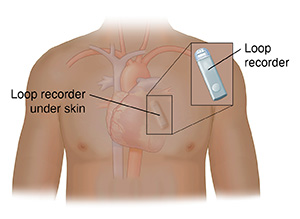Understanding Loop Recorder Implantation
An implantable loop recorder (ILR) is a device that records how your heart is working. A loop recorder may be implanted if you have problems such as:
-
Fainting, dizziness, or lightheadedness
-
Heart palpitations
-
Very fast or slow heartbeats
-
Unexplained falls
-
Possible hidden heart rhythm problems that can cause a stroke, such as atrial fibrillation
-
Certain gene disorders
During implantation, a small device is placed under the skin on your chest, over your heart. The device works as an electrocardiogram (ECG). It constantly picks up electrical signals from your heart. In most cases, an ILR works for up to 3 years.

How a loop recorder helps
You may need an ILR if other tests haven’t found the cause of your symptoms. An ILR constantly records your heart’s electrical activity. For example, if you faint because of an arrhythmia, the device records your heart’s activity before, during, and after you faint. Then your healthcare provider can see how your heart was acting.
Or you may need to trigger your ILR with an activator. This is a small, handheld device. You press a button on the activator when you are feeling symptoms. The ILR then records your heart’s activity. This device is very useful when you don't have symptoms often. Or you may use one if your provider needs to look at information about your heart over a longer period of time. Also, a monitoring device may be set up at your home to send data to your healthcare provider. It is either triggered by you or works automatically. Some devices can also link to an app on your smartphone.
Once the cause of your symptoms is found, you can be treated. You may need another small device to help control your heart rhythm. This may be a pacemaker or an implantable cardioverter-defibrillator (ICD).
How loop recorder implantation is done
The healthcare provider will first clean the area and inject local numbing medicine. They will then make a small cut (incision) in your skin just to the left of your breastbone (sternum). You may be covered with sterile cloths (drapes) to protect the area from infection. An insertion tool will then be placed under the skin where the cut was made. This makes a pocket for the recorder to sit in. The recorder is then placed under the skin and the tool is taken out. After, the cut is often closed with either surgical glue, stitches (sutures), staples, or steri-strips. The ILR is about the size of a AAA battery. It can be felt when pressing on the skin over it. And it may stick out slightly. Usually, it is not noticeable.
Your healthcare provider can take out the recorder in a similar way once enough data has been recorded or once the battery life ends.
Risks of loop recorder implantation
All procedures have some risks. The risks of this procedure may include:
Your own risks will depend on your age, your health, and other factors. Talk with your healthcare provider about the risks that most apply to you.